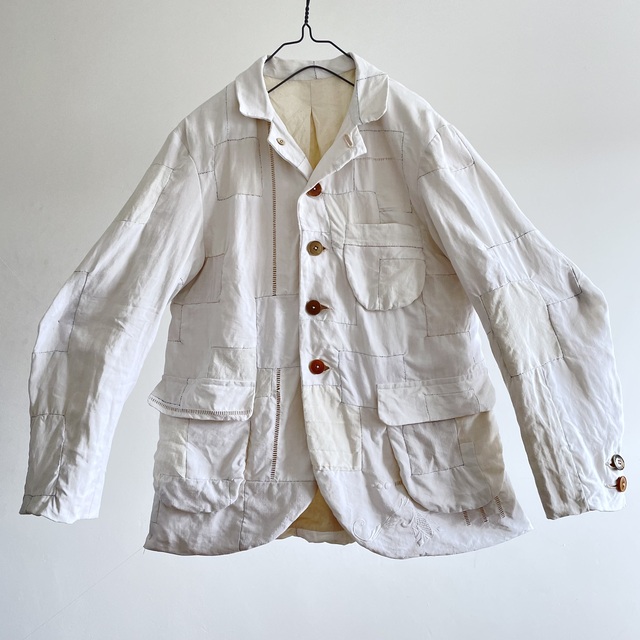SOLD
End of 19th Century Antique Hand Woven French Bed Linen Fabric Made Hand Sewn Patches Tailor Jacket
19世紀末~20世紀初頭の、数種類のフランスの手動織機で織られたアンティークリネンを、組み合わせ手縫いでpatchしたジャケット。ゆったりとした分量のゆるやかなシルエットが暖かで爽やかな風の季節に似合う1着です。
This jacket is made of antique linen woven on several types of French manual looms from the end of the 19th century to the beginning of the 20th century, and patched by hand in combination. The loose silhouette with a generous volume of fabric makes this jacket suitable for the warm and breezy season.


生地を上に被せてpatchするのでは無く、象嵌細工のように生地をくり抜きながらモザイク状に生地をpatchしていくフランス独特のpatch work=travail de patchだけが描き出せる不思議な魅力。
The patch work is not done by covering the fabric on top of the patch, but by hollowing out the fabric like an inlay work, and then patch the fabric in the form of a mosaic.



5mm以上ものピッチで太い糸を刺す刺し子や、ミシンで生地を叩きつけるパッチワークとは全く違う、静かな大人のpatch work。
Quiet adult PATCH WORK is completely different from stitching with thick threads at a pitch of 5mm or more SASHIKO, or from patchwork where the fabric is beaten with a sewing machine.


複雑に布の重なりの組み合わさったpatchは、ミシンでは無く、手で縫うからこその表情。
The intricately layered fabric patches have a look that can only be achieved by sewing by hand, not with a sewing machine.



patchされた生地の色の控えめなコントラストとちゃんと縫われた端々は、切りっぱなしの生地を貼り付けたpatchや、派手な色や柄の即興的なpatchとは、全く別の世界観です。
The subdued contrast of the colors of the patched fabrics and the properly stitched edges are a completely different worldview from patches that are just cut and pasted fabrics, or improvised patches with flashy colors and patterns.



綿素材を輸入に頼るのに比して自国での栽培が盛んで入手が容易で身近なフランスのリネン。しっかり使われた年月の経過を映す様々な質感と色合いが入り混じる深い趣を持つ生地は、枯れた風合いがさらに味わいを高めています。
In contrast to the dependence on imported cotton materials, French linen is easy to obtain and familiar because it is grown in France. The fabric has a deep taste with various textures and shades that reflect the passage of years of use, and the withered texture further enhances the taste.


フランスはリネンの原料のフラックスの一大生産地で、自身の上質なフレンチリネンのブランドを誇るとともに、今なお世界のリネン原料のフラックス(亜麻)生産の75%以上を生み出し続ける昔からのリネン大国です。しかしそのフランスも今では、原料栽培以外の工程(特に潤紡よる紡糸はほとんど中国)は国外で行われる事が殆どで、この生地が作られた頃のように、純粋なフレンチリネン生地が手に入る事は少なくなってしまいました。
France is a major producer of flux, the raw material for linen, and is proud of its own brand of high quality French linen. However, even in France, most of the processes other than the cultivation of the raw material (especially the spinning by moisture spinning, which is mostly done in China) are now done outside of France, and pure French linen fabric is no longer available as it was when this fabric was made.



綿素材を輸入に頼るのに比して自国での栽培が盛んで入手が容易で身近なフランスのリネンですが、しっかり着込まれた年月の経過を映す様々な質感と色合いが入り混じる深い趣を持つ生地は、枯れた風合いがさらに味わいを高めています。
French linen is easily available and familiar because it is grown in France, whereas cotton is imported. The fabric has a deep taste with various textures and shades that reflect the passage of years of hard wear, and its withered texture further enhances the flavor.


リネンと聞いてイメージされる硬さやざらつき、張りのある手触りといった予想を覆す、使いこまれた柔らかでくったりとした風合い。
It has a soft and soft texture that overturns expectations of hardness, roughness, and a taut feel that one might expect when hearing the word “linen”.



麻は使えば使い込むほど柔かさ、光沢感が増すと言われます。オールドリネンがもてはやされる事が示すように、リネンはつかいこまれた後が最も美しいのです。
It is said that the more linen is used, the softer and more lustrous it becomes. As the popularity of old linen shows, linen is most beautiful after it has been used.



機械技術がまだまだ発達しきっていない時代の、手仕事で麻を処理し、糸を紡ぎ、織り上げた味のあるリネン。
Tasteful linens are processed, spun, and woven by hand in an era when machine technology was not yet fully developed.


偶然と時間と人の手が紡ぎ出した、どこにでもありそうで、どこにもない1枚です。
It is a piece that seems to be everywhere, but is nowhere to be found, spun by chance, time, and human hands.


裏地をつけて手ですくって中縫いをした緩やかな顔つきのポケット。
Gently faced pockets that are lined and hand scooped and sutured.


ランダムにチョイスしたボタンはフランスのヴィンテージのcorozo(主にエクアドルのタグワ椰子)。実の中の種子の中の胚乳部分を加工して作られた趣のあるボタン。
19世紀から1950年代にかけてのプラスティック開発以前に、滑らかな手触りと硬さ丈夫さ染色性の良さを利用して、盛んに作られていたボタンです。
The buttons are vintage French corozo (mainly tagua palms from Ecuador). These quaint buttons are made by processing the endosperm part of the seeds inside the fruit.
Before the development of plastics from the 19th century to the 1950s, these buttons were actively made to take advantage of their smooth feel, hardness, durability, and dyeability.



vegetable ivoryの呼び名通りの乳白色の実を削って加工される何とも言えない丸みと、乳白色のベースを染める事で生まれる優しい色合いの魅力。見た目に反してしっかりした質感と重みを兼ね備えた、味わい深さを持ったボタンです。
As the name “vegetable ivory” implies, this button has an indescribable roundness created by shaving milky white berries, and the charm of the gentle coloring produced by dyeing the milky white base. Contrary to its appearance, this button has a solid texture and weight, and has a deep sense of taste.


変形の本切羽のカフスは、開けても折り返しても現代的なニュアンスを醸し、着こなす楽しみを広げるポイントになりました。
The surgeon’s cuffs, which can be opened or folded back, create a modern nuance, and are a key to expanding the enjoyment of wearing it.


ラスティックなコットンブロードは、適度な張りとシワ感が有り、インドで織られた素朴な糸の表情が魅力です。
手でまつりつけたライナーの生地感と色のコントラストと清潔感。柔らかな縫い皺は、手仕事ゆえのふくよかさ。
Rustic cotton broadcloth has the right amount of tension and wrinkles, and the rustic look of the yarn woven in India.
The liner is hand-patted to create a contrast in texture, color, and cleanliness. The soft stitching and wrinkles are the result of handwork.



ボタンホールはリネン糸でかがった手縫の素朴なタッチ。
Buttonholes are hand-stitched with linen thread for a rustic touch.


左前身頃の裾辺りと背中に配した白糸刺繍と呼ばれる、フランスの独特な技巧を凝らして刺繍された、厚みのある立体的なオーナメント。
The “white work” (la broderie blanche), a thick, three-dimensional ornament embroidered with a unique French technique, is placed around the hem of the left front and on the back.



刺繍糸を刺して作った土台を細やかなサテンステッチで覆って描き上げた、時間をかけた繊細な手仕事のみが作り出せたもの。
Only time-consuming and delicate handwork could have created this piece, which is drawn by covering the base made by stitching embroidery threads with fine satin stitches.


前身頃やフラップに配したのは、白糸刺繍とともにリネン類によく用いられたdrawn workと呼ばれる、フランスの手刺繍。部分的に抜き取った残りの糸をかがったり、渡した糸にステッチを行い、描き出された模様。
The front and flaps are decorated with French hand embroidery called “drawn work,” which is often used on linens, just as in the “white work. The pattern is drawn by stitching on the remaining thread that has been partially pulled out or passed over.



襟裏は細かなステッチと、手縫のcross stitch。
Fine stitching and hand-stitched cross stitching on the back of the collar.


手縫いならではの不揃いが作る趣。
The unevenness of the hand-stitched design creates a unique atmosphere.



「古くて新しく、新しいけど古い」もの。
Something “old and new, new but old.”


サイズ 2
肩幅 =45cm
バスト=55cm(脇下)
袖丈 =60 cm
着丈 =70cm
フランス/日本製
Front Fabric = Antique Hand Woven French Bed Linen / Linen 100%
Back Fabric = Indian Rustic Cotton Broad Cloth / Cotton 100%
Buttons = 1950-1960 Vintage French Corozo Button (Random Choice)
& Antique Fabric Covered Buttons
STOREへのリンク
End of 19th Century Antique Hand Woven French Bed Linen Fabric Made Hand Sewn Patches Tailor Jacket
[ALTERATION By Manure of Drawers] SOLD

